Welcome to our comprehensive guide on embracing Didiplis Diandra, also known as Scarlet Serenade, in your aquascape. Didiplis Diandra is a stunning aquatic plant that can add a touch of elegance and vibrant color to your underwater garden.
In this article, we will explore the unique characteristics of Didiplis Diandra, provide care tips for its healthy growth, and discuss the process of integrating it into your aquascape.
Join us as we dive into the world of Didiplis Diandra and discover how to create a captivating and thriving aquascape.
Didiplis Diandra, with its thin needle-like leaves and vibrant red tips, is a popular choice for planted aquatic tanks. Its delicate appearance and striking coloration make it a true standout.
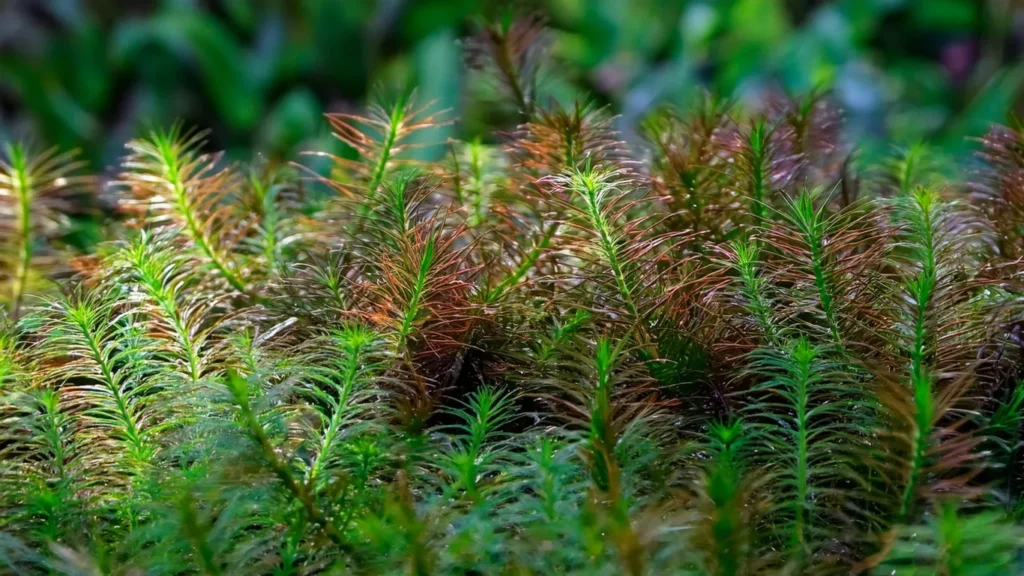
We will explore the origins of Didiplis Diandra and delve into its unique qualities that contribute to its charm and appeal.
Aquascape is complete with proper care for the plants it houses. In this guide, we will provide you with essential tips and techniques for nurturing Didiplis Diandra to ensure robust growth and vibrant hues.
From lighting and water parameters to trimming and maintenance practices, we will cover all aspects of caring for this beautiful aquatic plant.
Key Takeaway
- Didiplis Diandra, also known as Scarlet Serenade, is a stunning aquatic plant that can add elegance and vibrant color to your aquascape.
- Proper care and maintenance are essential for the healthy growth of Didiplis Diandra, including lighting, water parameters, and trimming techniques.
- Didiplis Diandra has unique characteristics, such as its fine foliage and vibrant coloration, making it a standout plant in any aquascape.
- Creating the ideal environment for Didiplis Diandra growth requires attention to factors like lighting, water parameters, and substrate choice.
- Understanding the conservation status and native habitat insights of Didiplis Diandra deepens appreciation for its beauty and significance in aquatic ecosystems.
Quick Stats
| Attribute | Details |
| Family Name | Lythraceae |
| Origin | North America |
| Height | 15-30 cm (6-12 inches), can grow taller under optimal conditions |
| pH Range | 6.0 – 7.5 |
| CO2 Requirement | Moderate to High |
| Growth Rate | Fast |
| Care Level | Moderate |
| Color Form | Green to Reddish under high light |
| Water Conditions | 22-28°C (72-82°F), soft to moderately hard water |
| Max Size | Can reach up to 30 cm (12 inches) or more |
| Lighting | High |
| Supplements | CO2 supplementation, high-quality liquid fertilizers, and iron for vibrant color |
| Placement | Mid-ground to Background |
| Propagation | Stem cuttings |
What Is Didiplis Diandra?
Didiplis Diandra, scientifically known as Didiplis diandra and commonly referred to as Scarlet Serenade, is an aquatic plant native to lakes and streams in the USA.
It is characterized by thin, needle-like leaves that can exhibit vibrant red tips when provided with optimal growing conditions.
This red stem plant is often admired for its striking coloration and delicate appearance, making it a popular choice for planted aquariums.
Natural Habitat And Origin
Didiplis diandra, commonly known as the Water Hedge, originates from North and Central America, primarily found in regions with wet soils such as marshes, bogs, and the edges of ponds or slow-moving streams.
It is native to areas spanning from the southern United States, including Texas and Florida, down through Central America to northern South America.
In its natural habitat, Didiplis diandra thrives in moist, boggy environments with access to ample sunlight.
Unique Characteristics Of Didiplis Diandra
- Didiplis Diandra boasts fine, needle-like leaves that create an elegant and delicate appearance in aquascapes.
- When the plant is provided with optimal growing conditions, the foliage can exhibit vibrant red tips, adding a striking visual element to your underwater garden.
- This unique characteristic enhances the overall aesthetic and allure of Didiplis Diandra.
Lighting Considerations For Optimal Coloration
- Intensity: Didiplis Diandra thrives under moderate to high lighting intensity. Ensure that the light reaches all parts of the plant to promote balanced coloration.
- Spectrum: Choose lighting fixtures that provide a spectrum in the range of 6500K to 8000K. This spectrum mimics natural sunlight and allows Didiplis Diandra to exhibit its true colors.
- Duration: Consistency is key when it comes to lighting duration. Aim for a photoperiod of 8-10 hours per day to mimic natural day and night cycles, promoting healthy growth and coloration.
Water Parameters
- It is important to maintain suitable water parameters to create an ideal environment for Didiplis Diandra.
- The recommended temperature range is between 72°F and 82°F (22°C and 28°C). Keep the pH level slightly acidic to neutral, ranging from 6.5 to 7.5.
- Also, maintain good water flow and gentle water movement to prevent stagnant areas and promote nutrient uptake.
Ideal Temperature For Growth
- Optimal Range: Didiplis diandra thrives best in water temperatures ranging from 22°C to 28°C (72°F to 82°F). Within this range, the plant experiences ideal conditions for growth, exhibiting robust development and vibrant foliage.
- Preference for Warmth: Being native to tropical regions, Didiplis diandra prefers warmer temperatures conducive to its natural habitat. Consistently maintaining water temperatures within this range fosters healthy metabolic processes and promotes vigorous growth in aquariums or aquatic setups.

Substrate Requirements
- Nutrient-Rich Substrate: Although Didiplis diandra can grow in a variety of substrates, it thrives best in a nutrient-rich substrate. Consider using a substrate specifically formulated for aquatic plants, such as nutrient-rich aquarium soil or clay-based substrates. These substrates provide essential nutrients to the plant’s roots, supporting robust growth and vibrant coloration.
- Fine to Medium Grain Size: The substrate should have a fine to medium grain size, allowing for adequate root penetration and anchorage. Avoid coarse substrates that may impede root growth or cause damage to delicate roots. A substrate with a particle size of around 1 to 3 millimeters is generally suitable for Didiplis diandra.
- Well-Draining: Ensure that the substrate provides good drainage to prevent waterlogging, which can lead to root rot and other issues. A well-draining substrate allows excess water to flow through, maintaining optimal oxygen levels around the roots. This promotes healthy root development and prevents the accumulation of anaerobic conditions that can be detrimental to plant health.
- Supplemental Root Tabs: While Didiplis diandra can absorb nutrients through its roots from the substrate, supplementing with root tabs or aquatic plant fertilizers can further enhance its growth. Root tabs provide a concentrated source of essential nutrients directly to the plant’s root zone, ensuring consistent nutrient availability for vigorous growth and lush foliage.
RELATED: Dwarf Chain Sword For A Lush Carpet In Your Aquascape
Design Principles For Midground And Background Placement
- Layering: Arrange the plants in layers, placing taller plants at the back and shorter plants towards the front to create a sense of depth.
- Contrast: Choose plants with contrasting colors, textures, and leaf shapes to add complexity and visual appeal.
- Proportions: Ensure that the size and density of Didiplis Diandra are in harmony with surrounding plants for a balanced and cohesive look.
- Open Spaces: Leave some open spaces between plants to create a sense of balance and prevent overcrowding.
- Background Focal Point: Consider placing Didiplis Diandra near a focal point in the background, such as a large rock or driftwood, to draw attention and create a focal point in your aquascape.
Recommended Tank Size
- Small to Medium Tanks: Didiplis diandra can thrive in small to medium-sized aquariums, typically ranging from 10 to 50 gallons. In these tanks, the plant can be effectively incorporated as a midground or background element, adding vertical interest and color contrast to the aquascape.
- Larger Tanks and Aquascapes: In larger tanks exceeding 50 gallons or in aquascapes with ample space, Didiplis diandra can be used as a versatile background plant or as a focal point in the midground. Its tall, slender stems and vibrant foliage can create a striking visual impact when planted in groups or clusters.
- Consider Tank Height: Since Didiplis diandra can grow relatively tall under optimal conditions, consider the height of the tank when selecting the appropriate size. Taller tanks provide more vertical space for the plant to reach its full height potential without overshadowing other plants or decorations.
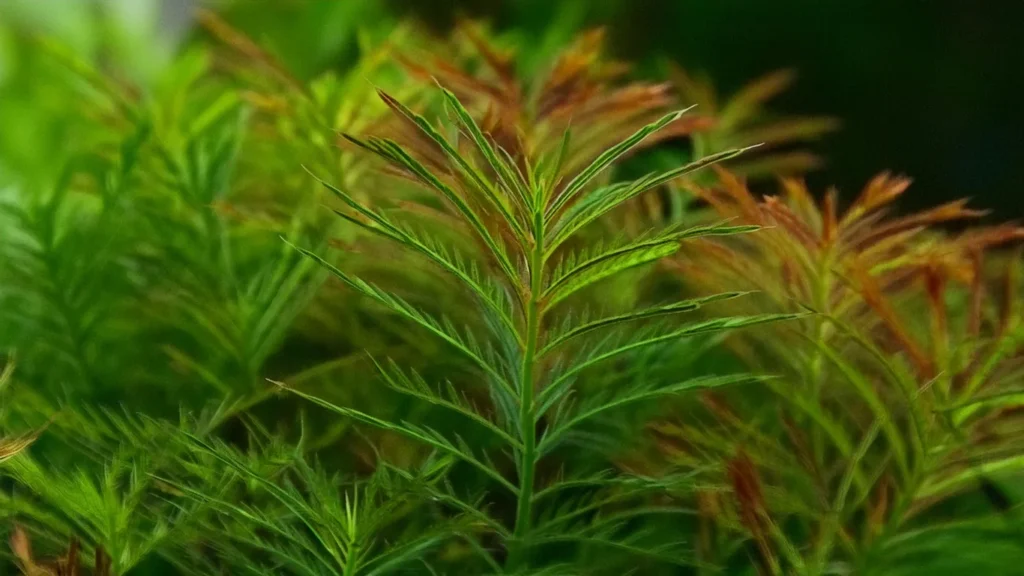
Complementary Plants For A Balanced Aquascape
Choosing complementary plants that complement the beauty of Didiplis Diandra is crucial for a balanced and visually appealing aquascape. Here are some suggestions:
- Anubias Nana: With its dark green leaves and compact size, Anubias Nana creates a striking contrast to the vibrant red hues of Didiplis Diandra.
- Java Moss: The fine, emerald green strands of Java Moss can add a delicate and textured look to your aquascape when combined with the bold colors of Didiplis Diandra.
- Dwarf Hairgrass: The lush, bright green foliage of Dwarf Hairgrass provides a beautiful foreground carpet that complements the taller Didiplis Diandra in the midground or background.
- Amazon Sword: Known for its large, graceful leaves, the Amazon Sword plant adds a touch of elegance and height to your aquascape, creating a dramatic backdrop for Didiplis Diandra.
Nutritional Needs Of The Plants
Didiplis diandra requires a balance of both macro and micronutrients to support healthy growth and vibrant foliage. Here’s an overview of its nutritional needs:
Macro Nutrients
- Nitrogen (N): Essential for overall growth and leaf development.
- Phosphorus (P): Promotes root development, flowering, and fruiting.
- Potassium (K): Aids in photosynthesis, water uptake, and disease resistance.
- Magnesium (Mg): Critical component of chlorophyll, necessary for photosynthesis.
- Calcium (Ca): Supports cell wall structure and overall plant integrity.
Micro Nutrients
- Iron (Fe): Crucial for chlorophyll synthesis and overall plant metabolism.
- Manganese (Mn): Facilitates photosynthesis and enzyme activation.
- Zinc (Zn): Essential for hormone regulation and enzyme function.
- Copper (Cu): Required for chlorophyll production and nutrient uptake.
- Boron (B): Aids in cell wall formation and sugar transport within the plant.
- Molybdenum (Mo): Necessary for nitrogen fixation and enzyme activity.
Cultivating The Plant
Cultivating Didiplis diandra involves careful preparation for growth, planting, and initial care to ensure optimal development:
Preparation For Growth
- Choose a suitable aquarium setup: Ensure the aquarium is adequately sized with appropriate lighting and filtration.
- Prepare the substrate: Use a nutrient-rich substrate to provide essential nutrients for plant growth. Consider adding root tabs or liquid fertilizers to supplement nutrient availability.
- Plan the aquascape: Determine the placement of Didiplis diandra within the aquarium, considering its growth habits and aesthetic preferences.
- Acclimate the plant: If transitioning from emersed to submerged growth, gradually acclimate the plant to submerged conditions by trimming any emersed growth and allowing new submerged growth to develop.

Planting
- Planting technique: Gently separate individual stems of Didiplis diandra and plant them into the substrate using tweezers or planting tools. Ensure the roots are well-covered with substrate to promote anchoring and nutrient uptake.
- Spacing: Plant stems of Didiplis diandra with adequate spacing to allow for growth and prevent overcrowding. Consider the plant’s eventual height and width when determining spacing between stems.
- Pruning: Trim any damaged or excess growth before planting to encourage healthy new growth and maintain the desired shape and density of the plant.
Initial Care
- Lighting: Provide moderate to high lighting to support photosynthesis and encourage lush growth in Didiplis diandra. Adjust the lighting intensity and duration based on the specific requirements of the plant and other aquatic inhabitants.
- Nutrient supplementation: Monitor nutrient levels in the aquarium and supplement as needed with liquid fertilizers or root tabs to ensure optimal nutrient availability for Didiplis diandra.
- Water parameters: Maintain stable water parameters, including temperature, pH, and hardness, within the recommended range for tropical aquatic plants. Conduct regular water changes to remove accumulated toxins and replenish essential nutrients.
- CO2 supplementation: Consider supplementing CO2 if necessary to promote robust growth and vibrant coloration in Didiplis diandra, especially in high-light setups.
- Algae control: Monitor the aquarium for algae growth and take proactive measures such as proper lighting, nutrient management, and regular maintenance to prevent algae outbreaks and ensure the health of Didiplis diandra and other aquatic inhabitants.
Plant Propagation Tips
- Stem Cutting Propagation: Trim healthy stems of Didiplis diandra into sections of 4-6 inches (10-15 cm) in length. Ensure each cutting has several nodes, which are the points from which roots will develop. Remove the lower leaves of each cutting to expose these nodes. Plant the stem cuttings securely into the substrate, making sure they are stable and have good contact with the substrate.
- Encourage Side Shoot Growth: To encourage bushier growth, allow Didiplis diandra to develop side shoots. Regularly prune the main stem, and new shoots will emerge from the leaf nodes along the stem. Once these side shoots have developed roots, they can be planted individually to propagate new plants.
- Division: As Didiplis diandra matures, it may develop into dense clumps. Divide these clumps into smaller sections, ensuring that each section has a portion of the root system attached. Carefully separate the sections and plant them into the substrate, taking care not to damage the roots.
- Maintain Stable Conditions: Provide stable water parameters, including temperature, pH, and hardness, to support healthy root development and overall plant growth. Sudden fluctuations in these parameters can stress the plants and impede propagation success.
- Supplement Nutrients: Ensure the substrate is supplemented with essential nutrients to support the growth of new plants. Consider using root tabs or liquid fertilizers designed for aquarium plants to provide a steady supply of nutrients to the roots.
Benefits Of Planting Didiplis Diandra
- Aesthetic Appeal: Didiplis diandra, with its vibrant red and green foliage, adds visual interest and contrast to your aquascape. Its delicate leaves sway gently in the water, creating a graceful and natural look.
- Oxygenation: Like all aquatic plants, Didiplis diandra contributes to oxygenation in the aquarium. During photosynthesis, it releases oxygen into the water, helping to maintain a healthy environment for fish and other aquatic inhabitants.
- Water Filtration: The dense growth of Didiplis diandra can serve as a natural filter, trapping debris and absorbing excess nutrients from the water column. This can help improve water quality and reduce the risk of algae growth.
- Habitat for Fish and Invertebrates: The dense foliage of Didiplis diandra provides hiding places and shelter for small fish, fry, and invertebrates. It creates a natural habitat within the aquarium, offering security and refuge for your aquatic pets.
- Natural Aquascape Design: Incorporating Didiplis diandra into your aquascape design adds depth and dimension to your tank. Its vertical growth and vibrant colors create a striking focal point or background feature, enhancing the overall aesthetics of the aquarium.
- Balance and Stability: Aquatic plants like Didiplis diandra play a crucial role in maintaining the ecological balance of the aquarium. They help absorb harmful substances, regulate nutrient levels, and stabilize water parameters, creating a healthier and more stable aquatic environment.
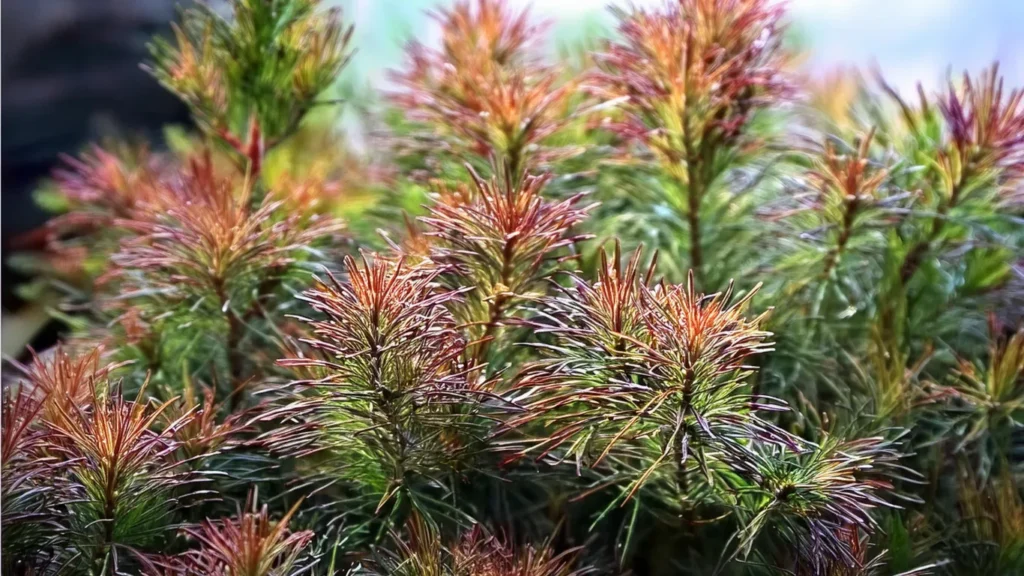
Fertilization And CO2 Supplementation
- Nutrient Supplementation: Ensure that your tank’s water column contains essential macronutrients and micronutrients needed for healthy plant growth. Regularly add a comprehensive aquarium fertilizer to provide these crucial nutrients.
- CO2 Supplementation: Carbon dioxide (CO2) is vital for photosynthesis and can significantly impact plant growth and coloration. Consider incorporating a CO2 system in your tank to provide an adequate supply of this essential gas to this plant.
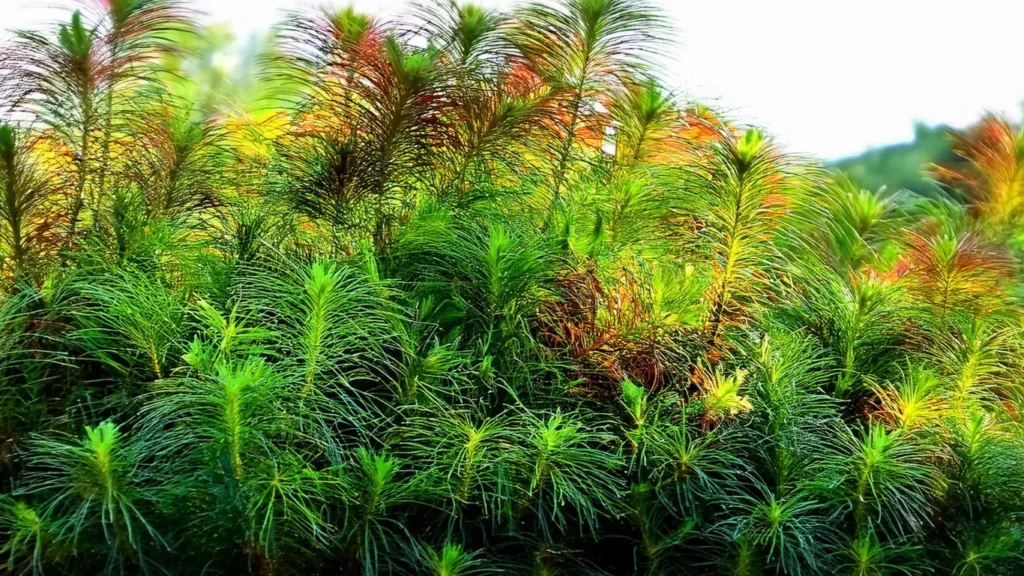
Integrating Didiplis Diandra Into Your Aquascape
Integrating this plant into your aquascape requires careful consideration of design principles and complementary plants. Placement is vital in achieving an aesthetically pleasing and balanced aquatic environment.
In this section, we will discuss the key principles for placing Didiplis Diandra in the midground and background of your aquascape, ensuring optimal visual impact and balance.
Additionally, we will provide suggestions for complementary plants that can enhance the overall aesthetic of your underwater garden.
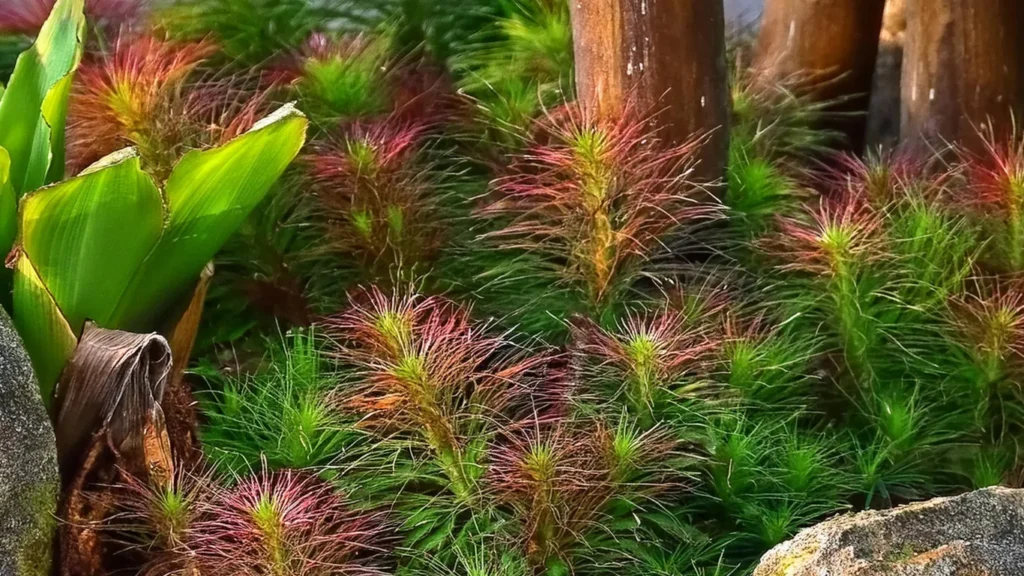
Conclusion
It is a captivating aquatic plant that can add beauty and elegance to your aquascape. By following the care guidelines and implementing the tips provided in this article, you can create a thriving and visually stunning underwater garden featuring Didiplis Diandra.
The Scarlet Serenade of Didiplis Diandra has the power to enchant your aquascape and inspire you further to explore the fascinating world of aquatic plant care.
From its unique characteristics and vibrant coloration to its easy propagation and integration into your aquascape, this plant offers endless possibilities for creating a captivating underwater masterpiece.
By understanding and providing the optimal environment, lighting, and nutrients, you can promote healthy growth and maintain the lush, bushy aesthetic that makes this plant stand out.
Frequently Asked Questions
What Distinctive Features Does Didiplis Diandra Bring To An Aquarium?
This plant, often celebrated for its fine, needle-like leaves, and intense reddish-pink hues under optimal conditions, contrasts the greenery typically found in planted tanks.
Its bushy growth habit and vibrant color make it an excellent choice for adding depth and visual interest, particularly in the midground to the background of aquascapes.
When provided with adequate light and CO2, it transforms into a breathtakingly colorful plant that can become the focal point of any aquarium.
How Do I Ensure Didiplis Diandra Thrives In My Aquarium?
To ensure it thrives, provide it with medium to high lighting, crucial for promoting its characteristic reddish-pink coloration. Supplementing CO2 will significantly enhance growth rates and color vibrancy.
It prefers soft to moderately hard water, with a slightly acidic to neutral pH. Regular dosing of micronutrients, especially iron, will help maintain its health and color.
Pruning is necessary to prevent lower portions from getting shaded and to encourage denser growth.
Can Didiplis Diandra Be Grown In Low-Tech Tanks Without Co2 Supplementation?
This plant can be grown in low-tech tanks without CO2 supplementation, but its growth will be slower, and achieving the vibrant red coloration may be challenging.
In low-tech setups, focus on providing as much lighting as possible within the limits of your setup, and consider using liquid carbon supplements. However, growth and coloration won’t be as pronounced as in high-tech setups with CO2 injection.
What Is The Best Way To Propagate Didiplis Diandra?
Propagating Didiplis Diandra is straightforward: it can be done by cutting the stem and replanting the cuttings in the substrate. Choose healthy, robust stems for cutting, ideally with multiple leaves.
Cut the stem at a length appropriate for your aquarium layout, typically a few inches long. Replant the cuttings into the substrate, ensuring they are spaced out enough to allow light to reach the lower leaves. Over time, the cuttings will root and grow into new plants.
How Does Didiplis Diandra Respond To Changes In Water Conditions, And How Can I Mitigate Any Negative Effects?
This plant can be sensitive to abrupt changes in water parameters, such as temperature, pH, and hardness, potentially leading to leaf drop or halted growth. Any changes to the aquarium environment should be made gradually to mitigate negative effects.
Regular, consistent maintenance routines, including water changes, testing, and nutrient dosing, will help stabilize conditions and support the health of this plant.
Acclimating the plant slowly when introducing it to your aquarium can also reduce stress and promote successful adaptation.
- Unveiling The Wonders Of Riccia Fluitans In Aquascapes - August 7, 2024
- Vallisneria Gigantea Var. Guide To Care And Cultivation At Home - July 31, 2024
- Vesicularia Dubyana Care & Growth Guide Tips For Beginner Gardeners - July 30, 2024
